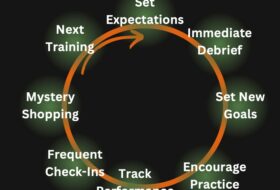We can’t help but be constantly reminded that we aren’t the only winery in our region. We simply cannot get away from each other, but that’s actually a good thing. We don’t go to a mall because they have one good store, we go for the selection of many good stores. So as an industry, we’re stronger and more interesting together as a region, offering a delicious discretionary item to enhance the enjoyment of life. Wineries are forever both competing with and complementing each other, whether to raise awareness for a specific region or a particular brand. But how can we possibly stand out from one another, create a strong brand impression and make our guests remember us specifically? To do that, we must find our individual, truly unique qualities that differentiate us from each other.
Green Fish
Figuring out what makes us unique is what at WISE we call identifying our “Green Fish.” What can only be said about your winery and not about any of the other wineries in your ’hood? Is it truly unique? Saying: “We’re family owned,” while interesting, is not unique. Of Napa Valley’s 400+ wineries, 95% are family-owned and operated. Bragging about our wines, saying “We are known for our [insert varietal here]” is also not going to set us apart from our neighbors since chances are, in the same AVA, we’re going to be producing the same or similar varietals. Identifying and communicating a winery’s “green fish” can be harder than it sounds. Finding ways in which our brand and each wine is truly unique sets the standard for differentiating ourselves from our neighbors.
Start with Why
If you’re struggling finding your “Green Fish,” start with ‘why.’ A great example of how to clarify your brand messaging comes from Simon Sinek’s Ted Talk on How Great Leaders Inspire. Borrowing from Simon . . .every company’s employees knows what they do. Some know how they do it. Very few people know why they do what they do. Making a profit does not count, that’s a result. The ‘WHY’ is the purpose. It is values-based. The right people – both employees and customers – will identify with it and that is what creates the connection that lasts far beyond the tasting room visit.
Sell the brand first. Sell the wine second.
Tasting room employees typically learn a lot of technical details about each wine and they are very eager to share that knowledge. What usually ends up happening with those who are not naturally strong sales people is that they start sharing all the ‘WHAT.’ For example, when presenting a wine to a guest, tasting room staff will talk about the wine’s aroma, color, body, taste, varietal components, AVA, etc. and then repeat that process for each wine. If we have a lot of SKUs this can turn into a huge laundry list of WHATs they have to memorize. After this list of WHAT, staff will sometimes then to the HOW – how their vineyard designates, soils, and clones differ. By the time the tasting is over, guests have heard far more facts than they could possibly remember.
One great way to really differentiate your brand when it comes to the tasting room experience is to share your WHY through memorable storytelling, and support this brand essence throughout your guest experience. Tell stories not just about the brand in general, but also about each wine. Bringing each wine alive with a story that talks about whythis wine is special, and connecting that back to the brand, is the best way to share the Green Fish, the why, the uniqueness of our brand.
WISE key points for landing your own Green Fish:
- Leverage your brand power – let your brand do more of the heavy lifting for you to surprise and delight your customers. Our winery brands are much more than our individual products. Your brand essence, the persona of your winery, is what sets you apart.
- The brand promise, personality and experience should be shared with each customer. Every winery team member should be able to share the key winery brand messages in many compelling and comfortable ways.
- The real secret here is to “Sell the brand first and then sell the wine second.” Focus on three key brand points and at least one “green fish” – something truly unique – to share with your guests.
Do your own ‘gut checks’ and visit other wineries. Are you clear on what makes each winery unique?
We don’t have to be Dr. Seuss to make a story stick, but if we start with our “Green Fish,” we’re far more likely to succeed in creating a memorable brand impression that differentiates us from our neighbors.




